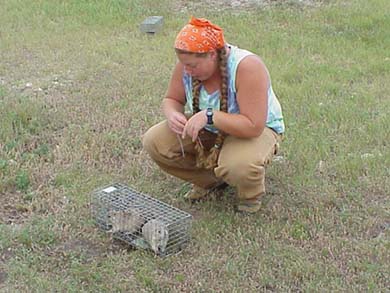Spatial Dynamics of a Bacterial Pathogen: Sylvatic Plague in Black-tailed Prairie Dogs
 Investigators:
Investigators:
Tammi Johnson, M.S. Student
Dr. Jack Cully
Project Supervisor:
Dr. Jack Cully
Funding:
EPA, USGS, KDWP, U.S. Forest Service Cooperators
Sharon Collinge, Chris Ray, and David Augustine
Location:
Western Great Plains
Completion:
April 30, 2007
Objectives:
Map prairie dog colonies, identify spatial dynamics of plague, and determine effects of plague on prairie dog abundance.
Progress and Results
Black-tailed prairie dog (Cynomys ludovicianus) populations have declined by as much as 98% during the past 100 years. Several factors have contributed to this decline including intentional poisoning, habitat loss and sylvatic plague. During the past 60 years, plague may have been the most significant cause of decline Sylvatic plague is an exotic vector-borne disease caused by the bacterium Yersinia pestis and causes mortality rates approaching 100% in black-tailed prairie dog colonies. Plague epizootics in black-tailed prairie dogs are often widespread, with groups of colonies typically extirpated in a short period of time. Plague may be transmitted among prairie dog colonies via two mechanisms: (1) epizootic transmission, in which plague cycles among prairie dog colonies via the movement of infected prairie dog fleas by dispersing prairie dogs or perhaps the movement of infected fleas by predators such as coyotes, and (2) enzootic transmission, in which reservoir species such as northern grasshopper mice (Onchomys leucogaster) and deer mice (Peromyscus maniculatus), transmit infected fleas to prairie dogs. Our research aims to quantify the effects of sylvatic plague on the metapopulation structure of black-tailed prairie dog colony complexes and to determine if metapopulation structure, in turn influences the spread of plague among colonies.
We examined spatial patterns of colonies in areas with and without a history of plague to identify landscape scale effects of plague on black-tailed prairie dogs, as well as factors that influence intercolony transmission in complexes where plague was present. The presence of sylvatic plague in black-tailed prairie dog colonies significantly alters the spatial structure of colony complexes. Colony complexes with a history of plague are composed of smaller colonies with greater intercolony distances, while complexes where plague is absent are primarily composed of more large colonies in close proximity to neighboring colonies. We can conclude from this portion of the project that sylvatic plague increases the degree of colony isolation. Multistate modeling illustrated the mechanisms expected to have the most impact on intercolony transmission of plague. Colony area, distance to the nearest neighboring colony and distance to the nearest drainage, which may function as dispersal corridors, were the most important factors for predicting the probability of plague entering colonies.
Products:
Peer-reviewed Publications:
Johnson, T.L., J. F. Cully, Jr., S. K. Collinge, C. Ray, C. M. Frey, and B. K. Sandercock. 2011. Spread of plague among black-tailed prairie dogs is associated with colony spatial characteristics. Journal of Wildlife Management 75:357-368.
Cully, J. F., Jr., T. L. Johnson, S. K. Collinge, and C. Ray. 2010. Disease limits populations: Plague in black-tailed prairie dogs. Vector Borne and Zoonotic Diseases 10:7-15.
Augustine, D. J., M. R. Matchett, T. P. Toombs, J. F. Cully, Jr., T. L. Johnson, J. D. Sidle. 2008. Spatiotemporal dynamics of black-tailed prairie dog colonies affected by plague. Landscape Ecology 23:255-267.
Augustine, D. J., J. F. Cully, Jr., and T. L. Johnson. 2007. Influence of fire on black-tailed prairie dog colony expansion in shortgrass steppe. Rangeland Ecosystem Management 60:538-542.
Johnson, T. L., and J. F. Cully, Jr. 2005. Effects of colony connectivity on the spread of sylvatic plague (Yersinia pestis) in black-tailed prairie dogs across the Great Plains. Second Symposium proceedings, The history, ecology, and economy of the Thunder Basin prairie ecosystem. J. B. Haufler, ed. Compact Disk.
Thesis or Dissertation:
Johnson, T.L. 2005. Spatial Dynamics of a bacterial pathogen: Sylvatic plague in black-tailed prairie dogs. M.S. Thesis. Division of Biology, KSU. Manhattan.
Presentations:
Cully, J. F. and T. L. Johnson. 2008. Plague regulates black-tailed prairie dog populations. Symposium on the Ecology of plague and its effects on wildlife, Fort Collins, CO.
J. F. Cully and T. L. Johnson. Spatial dynamics of plague in three black-tailed prairie dog complexes, (Oral presentation) at the Annual Meeting of the Wildlife Disease Association, Estes Park, CO, August 2007.
Johnson, T.L. and J.F. Cully, Jr. Colony Spatial Dynamics Influence the Transmission of Sylvatic Plague in Black-tailed Prairie Dogs. Featured Student Presenter, Wildlife Disease Association International Conference, Cairns, Queensland, Australia. *2005 Graduate Student Research Award.
Johnson, T. L. and J. F. Cully, Jr.. 2003. Black-tailed prairie dogs and sylvatic plague: Landscape dynamics of an emerging disease. Annual meeting of the American Society of Mammalogists, Lubbock, TX.
Cully, J. F., B. R. Erie, T. L. Johnson, and B. Thiagarajan. 2003. Rodent Associates of black-tailed prairie dogs in areas with and without plague. Annual meeting of the American Society of Mammalogists, Lubbock, TX.
Cully, J. F., B. R. Erie, T. L. Johnson, and B. Thiagarajan. 2003. Rodent Associates of black-tailed prairie dogs in areas with and without plague. 58th International Conference on Diseases in Nature Communicable to Man. Flagstaff, AZ.
Johnson, T. L., and J. F. Cully, Jr. 2003. Black-tailed prairie dogs and sylvatic plague: Landscape dynamics of an emerging disease. Paper presented at the Kansas Chapter of The Wildlife Society meeting, Kansas State University, Manhattan, KS.